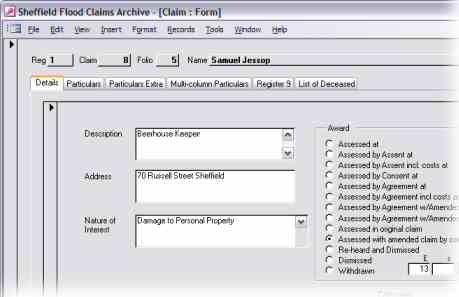
 |
||
| > SFCA Home | > About the Project | > SFCA Search |
 After
the database had been devised and trialled (January-July, 2004), the lengthy task of inputting the Claims
into the database began. Since the Registers had to remain at Sheffield Archives all inputting had to
be done on site, and so three inputters keyed the information into databases stored locally on laptops.
Each week the new information was added to the master database and this was uploaded to the website
so that people could see work in progress. The inputting of the Claims was finished by the middle of
2005. The Claims were double-checked for errors on the web-version.
After
the database had been devised and trialled (January-July, 2004), the lengthy task of inputting the Claims
into the database began. Since the Registers had to remain at Sheffield Archives all inputting had to
be done on site, and so three inputters keyed the information into databases stored locally on laptops.
Each week the new information was added to the master database and this was uploaded to the website
so that people could see work in progress. The inputting of the Claims was finished by the middle of
2005. The Claims were double-checked for errors on the web-version.
The inputting was slow at the start because many terms were unfamiliar and the handwriting was often difficult to read (see below, ‘View from the Inputters’). Where words were unclear a picture was taken and the query circulated to a number of local historians (Jean Cass, Tanya Schmoller, Karen Lightowler), and they in turn often showed these queries to others (Ken Hawley at the Hawley Collection; Karen’s father). This helped clear up many uncertainties and also helped the inputters build up quite a contextual knowledge which meant that inputting speeded up. Once the Claims had been digitised the process of associating the Claims to map locations began.
We encountered several problems interpreting the copperplate script. Learning the basic characters, eg. the double S, was fairly straightforward. Most of the clerks who entered the claims into the registers had relatively legible handwriting. But one clerk wrote in tall spindly chicken scratchings which were very difficult to interpret, especially since many of his lower case letters looked identical; for instance, it was nearly impossible to distinguish an l from a t, or an a from an e or o or c, so we would sometimes have to make decisions based on what we already knew of the terminology and geography. If a word was illegible, and its meaning not obvious through its context, then we would note it in Explanatory Notes. We tried not to be too pedantic, but it sometimes seemed difficult to get the balance right.
Another clerk who had impeccable handwriting was a terrible speller, so it was difficult to determine if an odd spelling of a word was a variant spelling (eg. ‘panshon’, ‘panchion’, ‘panchon’…) or simply this clerk’s mistake (eg. ‘inflamation’ for ‘inflammation’ and ‘Gibralter’ for ‘Gibraltar’).
We found a number of discrepancies as to the names and addresses of claimants. For instance, the surname Tingle appears as Fingle in another claim for the same person. This sort of mistake was probably our misreading of the claims. But in other cases discrepancies were possibly due to a clerk either misreading or mis-hearing the name, as in Caffery and Caffray.
Therefore, when searching in the Names Index it is advisable to try several possible spellings of the surname, as there may be more than one Index entry for the same person. For instance Armitage has also been spelled Armittage and Armatage, and Wood has been spelled Woods.
Sometimes we had to deviate from the layout used in the register, but we tried to ensure the same sense was conveyed. If we had to make too many alterations we would describe the original layout in Explanatory Notes.
|
|

|
|